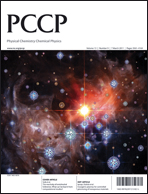The impedance spectroscopy studies performed for two strongly hydrogen-bonded liquid amides: N-methylpropionamide (NMP, CH3·NH·CO·C2H5) and N-ethylacetamide (NEA, C2H5·NH·CO·CH3) have shown that the two centers of the peptide linkage, –NH·CO–, active in the C![[double bond, length as m-dash]](https://www.rsc.org/images/entities/char_e001.gif) O⋯H–N hydrogen bonds formation, exhibit quite different sensibilities to the steric screening effects. In contrast to the oxygen atom, a relatively small change (CH3– to C2H5–) in the screening of the hydrogen atom leads to an essential decrease of the degree of the amide self-association. As a consequence, both the static dielectric permittivity and the orientational entropy increment of NEA are essentially lower than those of NMP. However, it was found that the dynamic processes studied are only weakly influenced (in the case of dc conductivity, σDC) or totally not influenced (the dielectric relaxation time, τD) by the different degrees of NMP and NEA self-association. The experiment shows that for both the amides, the logσDCvs. logτD dependence is nonlinear and can be described with the fractional Stokes–Einstein–Debye relation, σDCτsD ≅ const, with the exponent s varying from about −0.8 to about −0.6 in the temperature range from 5 °C to 110 °C.
O⋯H–N hydrogen bonds formation, exhibit quite different sensibilities to the steric screening effects. In contrast to the oxygen atom, a relatively small change (CH3– to C2H5–) in the screening of the hydrogen atom leads to an essential decrease of the degree of the amide self-association. As a consequence, both the static dielectric permittivity and the orientational entropy increment of NEA are essentially lower than those of NMP. However, it was found that the dynamic processes studied are only weakly influenced (in the case of dc conductivity, σDC) or totally not influenced (the dielectric relaxation time, τD) by the different degrees of NMP and NEA self-association. The experiment shows that for both the amides, the logσDCvs. logτD dependence is nonlinear and can be described with the fractional Stokes–Einstein–Debye relation, σDCτsD ≅ const, with the exponent s varying from about −0.8 to about −0.6 in the temperature range from 5 °C to 110 °C.

You have access to this article
 Please wait while we load your content...
Something went wrong. Try again?
Please wait while we load your content...
Something went wrong. Try again?
![[double bond, length as m-dash]](https://www.rsc.org/images/entities/char_e001.gif) O⋯H–N hydrogen bonds formation, exhibit quite different sensibilities to the steric screening effects. In contrast to the oxygen atom, a relatively small change (CH3– to C2H5–) in the screening of the hydrogen atom leads to an essential decrease of the degree of the
O⋯H–N hydrogen bonds formation, exhibit quite different sensibilities to the steric screening effects. In contrast to the oxygen atom, a relatively small change (CH3– to C2H5–) in the screening of the hydrogen atom leads to an essential decrease of the degree of the 

 Please wait while we load your content...
Please wait while we load your content...